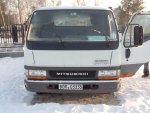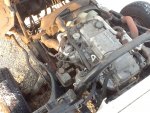Just sitting the Mitsu chassis on top with a few adaptors is kind of what I was thinking.
If the cab tilt is by torsion bar then you’ll need to keep at least 30cm of Mitsu chassis just to the torsion bar has a lever.
I don’t think the height of the engine is going to be the deciding factor; before you strip off the Toyota get it crossed up with a wheel in the air and see how high the front wheel pushes up into the wheel well. You’ll have to measure it relative to the chassis to know how high to put the cab. It’s possible you’ll need to either find a narrower radiator, or work out a way of putting it in front of and tipping with the cab. Move the grill forward and pass the hoses via the pivot point.
Now, the box.
When reading your construction method I have to confess to rolling my eyes upwards. Metallic frame construction has it’s place I’ll recognise: on oil rigs, ships, bridges, 747s and other equally obsolete things.
For decades now refrigerated van converters have been building very tough lightweight bodies with a view to tolerating floppy lightweight car/van chassis while being able to put up with bumps and scratches, easily repairable with a bit of fibre charged resin.
And light! The newer 3.5 tonne rule means that there is a proliferation of fridge vans designed to optimise the limited loading capacity without using up too much of that capacity for the box.
Two minutes on Mobile.de brought up these:
http://suchen.mobile.de/fahrzeuge/showDetails.html?id=133380749&lang=en&__lp=62&scopeId=VUT75&sortOption.sortBy=searchNetGrossPrice&makeModelVariant1.searchInFreetext=false&makeModelVariant2.searchInFreetext=false&makeModelVariant3.searchInFreetext=false&vehicleCategory=VanUpTo7500&segment=Truck&negativeFeatures=EXPORT&grossPrice=false&category=RefrigeratorBox&pageNumber=1 absolutely perfect for what you need. Don’t like the door? Silicone it up and cut your own; they’re self supporting and soo easy to work on. The corners already have alu strips for branches to slide on, you just have to meet them with branch deflectors mounted on the cab. There are longer ones you can cut down; and that's without compromising the box's strength.
WestySS has a build thread here showing just how good this stuff is to work with. You could even glue up your own, there are several suppliers around Europe who will make panels to measure (but it’s pricey)
Before cutting up the Mitsu, drive up to Warsaw and pick up a box. On the relatively stiff Toyota chassis you could easily get away with simple rubber mounts rather than add a heavy torsion free subframe. I promise you a plastic box will be up to the job, and in terms of insulation you won’t get better.
Hell there’s even a high performance cooling system you can plumb into the Toyota’s aircon compressor, a three way valve could direct the cooling back, front or both..
I passed a relatively modern looking Dyna this morning, looked like another potential donor. Maybe being Toyota there are a few parts in common. Maybe not.
Of course you can do what you like, these are nothing more than my opinions based on what I've experienced.
However all over Europe and in North America if a vehicle is registered as a Motor Caravan there is no tacho obligation whether it's 4 or 14 tonnes. In the Us you're even allowed to drive one of those huge bus motorhomes on a car licence. In France the toll roads are height based so your low one should slip through. In Spain it's the number of wheels, so super singles are the way to go.
Happy planning.



